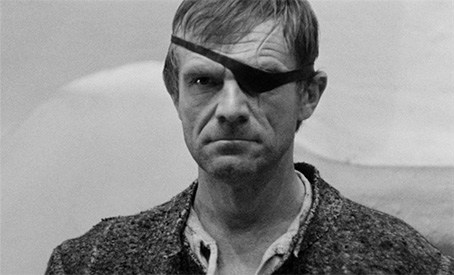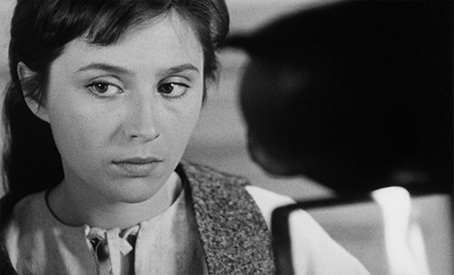|
I love being deliberately and successfully misdirected by a film, particularly if it's done with the sort of purpose and artistry as you'll find in the compelling first half of Eduard Grečner's extraordinary 1968 Dragon's Return [Drak sa vracia]. It begins with a portentously scored circular pan of a remote mountainous region during a deliberately unspecified period in history, which concludes just as a lone male figure drifts into frame. Dwarfed by the landscape, he has his back to us and is standing next to the twisted remains of a tree that may or may not have expressionist value. The unsettling music continues as a woman prepares a meal in her white-walled home, then pauses her actions and seems to sense something; a presence, perhaps, a troubling disruption to her everyday norm. As if responding directly to the woman's curious glance, the figure briefly seen in the opening shot turns to a reveal a stern and weather-beaten face, one sporting a black eye-patch and a livid facial scar. It's a countenance that seems to ooze trouble from every pore. What has actually prompted the man to turn his head is local man Zachar, who has just rolled up on the back of a horse-drawn cart and offers the man a lift to the village located at the foot of the mountain. "Don't you recognise me?" the scar-faced man asks. Zachar clearly does and belts off towards the village at a frantic gallop. "Dragon's back!" he shouts as a warning on his arrival. Pandemonium ensues. "Dark days are coming!" one woman cries, "Dragon's back!" If you weren't already convinced of the scar-faced man's malevolent purpose, it turns out that he's named after a mythical, fire-breathing reptilian monster.

By the time Dragon arrives in the village under his own steam, the local menfolk are gathered in the pub and are debating what to do about his worrying return. "It's Šimon's business," one man suggests. A short while later the Šimon in question returns home to Eva, the woman we first encountered in the opening scene. She serves him food, which he is unable to eat. Neither she nor he seem remotely comfortable in each other's presence – they make no eye contact and no words pass between them until Šimon gets up to leave. "He's come back for you," he tells the woman we presume is his wife. "Dragon is back."
The conviction that Dragon is a bitter avenger with a terrible past who is biding his time before unleashing who knows what on these peaceable locals is enhanced when he walks into the pub and all conversation immediately ceases. He walks up to the bar, swallows a couple of drinks, chews briefly on some food and silently departs. From the moment he leaves he is the topic of fevered conversation. Just what is going on here? Not, it turns out, what the film has used our own media-formed preconceptions have led us to suspect. Quite the opposite, in fact.
And here's where it gets a little tricky for me, as to say much more would involve delivering an unfair sprinkling of spoilers. The gradual unfolding of the truth, primarily through a series of hauntingly executed and precisely positioned flashbacks, constitutes one of the film's principal pleasures, as they force us to re-evaluate everything we've seen and re-examine how and why we found it so easy to interpret events and characters the way that we did. But this does make if difficult for me to comment on what happens in the film's second half without discussing plot points that should ideally not be revealed in advance. What I will say is that it consists of a long and arduous journey undertaken by Dragon and the aforementioned Šimon, one in which we are again invited to be distrustful of Dragon's true intentions. By this point, however, we are better positioned to comprehend and more accurately interpret his actions than the suspicious, prejudicial and vindictive Šimon.

A morality tale, then. Well, in a way yes, but director Eduard Grečner is neither preaching nor attempting to highlight the obvious, but using this lesson in the still pertinent dangers of prejudicial ignorance and the mob mentality as the basis for a work of consistently mesmerising audio-visual poetry. Crucial to this is the astonishing experimentalist score by Ilja Zeljenka, who also provided the memorably unsettling music for Stefan Uher's The Sun in a Net (on which Grečner was assistant director). As unconventional and operatically haunting as Popol Vuh's famously dreamlike music for Werner Herzog's Aguirre, the Wrath of God, it has a transformative effect on the action it underscores, infusing even the calmest scenes with a discomforting sense of almost apocalyptic and even alien menace, and landscapes with an air of sometimes spiritual wonder. So wedded is the music to the visuals that, as Jonathan Owen highlights in the accompanying booklet, there are times when the score and the sound effects seem to meld into each other, and others when one element of the soundtrack becomes so purposefully dominant that all other sound (and occasionally all sound) is pushed into silence. Intermittently, I couldn't help but suspect the influence of Hungarian avant-garde composer Györgi Ligeti (this may be purely co-incidental, of course), and there are elements here that I'd swear made their way into the tribal themes of John Corigliano's work on Ken Russell's Altered States.
Visually, the film is arrestingly crafted, with Grečner making telling use of cinematographer Vincent Rosinec's sometimes breathtaking wide shots to bring home the role that the mountains that surround the village play in shaping the lives and the destinies of those who live within their shadow. But it's in the manner in which he frames the characters that Rosinec's work here really hits home, from the follow pans of Dragon, Šimon or Eva as they move they move through the village, the landscape or the interiors of buildings, to the telling close-ups employed to capture their emotional responses or focus our attention on objects whose relevance only becomes clear over time. Most memorable of all is a handsomely executed flashback shot that sweeps up to and around Dragon and Eva, an emotive camera movement that is later repeated in modified form with different participants to powerful effect, coming to rest as the distant and indistinct figure of Dragon slips tellingly into frame. Sorry, but you'll need to see the film to understand why this delivers such a kick.

The work of editor Bedrich Voderka (another The Sun in a Net alumnus) is equally important to the storytelling and substructure, aiding Grečner in his early character misdirection, economically expanding on character detail and forging implicit links between Dragon and Eva from an early stage. Repeatedly, the two appear to turn and look at each other despite their locational distance, a technique that suggests an almost telepathic bond but later feels more triggered by specific memories. Elsewhere, a combination of imagery, sound and a single edit is employed to subtly suggest a link between the pagan rituals of female villager elders, the roaring fire of Dragon's kiln, and the burning forest in which the village's cowherd is trapped.
Dragon's Return (and I can't emphasise enough how much I prefer that translation to the stiffly formal alternative found on IMDb, ‘The Return of Dragon') is a beautifully handled and quietly compelling example of why 1960s Czech and Slovak cinema remains one of the major epicentres of film creativity of the period. This was my first exposure to the work of Eduard Grečner, and I was so captivated by it that I was drawn back to it repeatedly in the days that followed. Each time I drew something new from the film and saw specific elements in a different light – I was three viewings in before it struck me that it also played as a still too-relevant story of a creative mind ostracised by a community swathed in superstition and ignorance. My reluctance to specifically discuss aspects of the film for fear of spoiling things for newcomers means that I've only scratched (and dug a little bit below) the surface of what this remarkable work has to offer. Fans of 60s Slovak cinema should need no further persuading, and for those of you who have yet to experience its varied and often thrilling delights, this is a damn fine place to start.
Although the result of a new high definition restoration, it's worth remembering that the film has been effectively off the radar for a good many years and it seems unlikely that the restoration team had pristine original materials to work with. There is thus some variance in the image sharpness, which while seriously impressive on close-ups can soften a little in some of the wide shots. There is some slight flickering visible here and there and the contrast just occasionally feels just a little too punchy (the black levels are solid throughout), but in all other respects this is a very fine transfer. The monochrome tonal range is attractively reproduced, the image sits solidly in frame with no trace of jitter and is clean of any dust and damage. The best material really does look good. The framing is 1.66:1 anamorphic.

The Dolby 2.0 mono soundtrack has some inevitable restrictions in its dynamic range, but the sound effects and music – so crucial to the film's texture and artistic makeup – are very clearly reproduced, and there's no background hiss or damage to contend with.
The optional English subtitles are always clear, whatever the background.
An Introduction to the Film by Peter Hames (22:18)
The author of The Czechoslovak New Wave provides a concise introduction to Czech and Slovak New Wave cinema and the career of director Eduard Grečner, before focussing more specifically on Dragon's Return. His analysis of the film's many qualities is detailed and perceptive, with specific coverage of the music score, the camerawork, the film's intriguing blend of folklore and modernism, and more. I was kicking myself for not picking up of the parallels with American westerns and particularly The Searchers, and was interested to hear that this is widely regarded as Grečner's best film. Grečner's contribution to The Sun in a Net is also touched on here. There are no real spoilers, but clips from the film's final scene are included.
Booklet
The key inclusion here is a detailed and engrossing essay on director Eduard Grečner that leaves my piece above looking seriously anaemic, though does include some major spoilers (the whole plot is laid out, including the ending), so I'd save this until after you've seen the film. You'll get more from it then anyway. This is followed by an interview with Grečner conducted by Jonathan Owen, which provides some welcome insight into the director's intentions for the film, and helps confirm a few things that might otherwise remain the subject of critical speculation.
Once again I find myself bowing down at the altar of Second Run DVD, who with this disc are making Grečner's film available on home video for the first time anywhere in the English-speaking world. Obviously, not everyone is as enthusiastic for Czech and Slovak cinema as we are here at Outsider, but for those who thrill at discovering films from years past that leave much of what we tend to be served up today looking flat and unadventurous, this is another must-have from this most dedicated of UK distributors. Highly recommended.
|